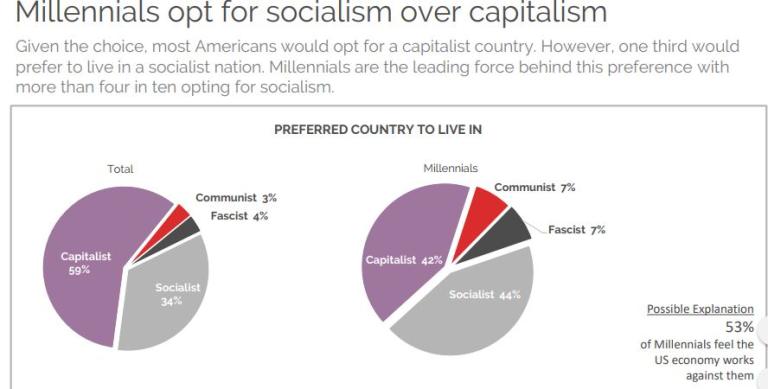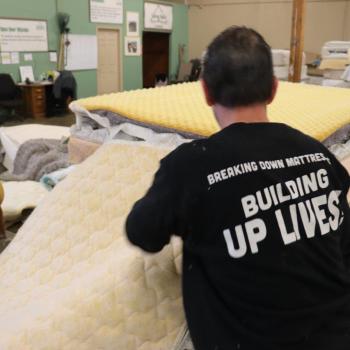This report ought to stop you in your tracks.
It shows an entire generation that prefers socialism and communism over capitalism.
It shows great discontent with American economics.
It shows a lack of hope for the future.
The Victims of Communism Memorial Foundation released its “Annual Report on U.S. Attitudes Towards Socialism”. The survey showed a well-defined generational gap regarding communism and socialism between older and younger Americans.
Whereas 80 percent of baby boomers and 91 percent of elderly Americans believe that communism is a problematic system, just 55 percent of millennials say the same.
Half of Americans aged 16-20 say they would vote for socialist, 21 percent for a communist. And there is remains great confusion between the definitions of fascism/socialism and communism. (Here’s a good chart in case you need a refresher)
Given the choice, most Americans would opt for a capitalist country. However, one third would prefer to live in a socialist nation. Millennials are the leading force behind this preference with more than four in ten opting for socialism.

I’m not going to dismiss this as ignorance or silliness as some have. I believe Millennials and Gen-x ers have really thought this through. They’ve given up hope.
Try something else
I’m apologizing to my children and all the other millennials. This is not the world we meant to leave you.
The past election cycle and all the blow back since has exacerbated the problem. Politics are not even appealing, as the name-calling-mud-slinging-tired-promises message is simply not resonating.
Younger people saw the supposed “best of the best” on the stage last year, the final two candidates. This video by Mark Gungor compared the two as the choice between “a pig and a criminal.”
No wonder the youth are losing hope.
Two out of three millennials saw Hillary Clinton as “dishonest.” Only 19 percent saw Donald Trump as “levelheaded.” Their chosen candidate, Bernie Sanders is a proclaimed Socialist and even after his defeat remains widely admired.
My generation has spawned back-breaking debt, which no one talks about today. But a check with the US Debt Clock shows federal spending has driven us to more than $20 trillion in debt. And the number keeps spinning. That’s $169,000 per taxpayer – all ages include.
Churches, in a mad dash to appear relevant have lost their relevance. They installed ash trays outside the buildings and pastors started talking hip-hop and the music grew louder but the call to something pure and true has fallen to a whisper.
Our promise that education would lead to prosperity has proven a farce. Between 1985 and 2015, schools increased theirs costs fivefold and yet the corresponding wages for graduates have fallen.
I get the appeal
This is not really news. Actually, the ideas (and their torchbearers) are quite old. Socialism, the redistribution of wealth, providing vital benefits and social services through the state was idea popular in the ’60s — and the ’30s even in the 1910’s!
In the United States, a full 51% of people aged 18–29 do not support capitalism. That’s why when Bernie Sanders talked about seizing the wealthy of the rich, nationalizing large industries, and instituting single payer healthcare, it was appealing. In the 2016 primaries, Sanders won more votes from people under 30 than Clinton and Trump combined.
But it’s because millennials, in their lifetimes, they’ve never seen a system that works.
I wish they would think about the big picture, about just who is going to pay for this. But in our current system, no one is thinking about that either. For every two dollars spent by our government, another dollar is borrowed. That’s a disaster in any home, and certainly not sustainable for a government.

The idea of turning it all off and trusting government for solutions seems so easy. But the history of socialism isn’t pretty.
Socialism sounds like “social justice,” with appeals that seem compassionate and Christian. But stealing from others – even if they are rich – is not a faith value. And the entire thought process is based on envy, a deadly sin if I ever saw one.
Here’s where the real hope is
I go to a church packed with Millennials, Gen –X ers and little baby toddlers. I see in their faces hope. They are living in community, apart from the news cycle.
They have hope because Christianity offers answers they can’t get anywhere else.
While churches have been part of the problem, if done right they can be part of the answer.
Our youth don’t want to see God as a buddy. They are over that. They want to hear about the God of the Bible – tough on sin, but easy on forgiveness. They want black and white, even if it means being uncomfortable. Our pastor talks often about “embracing the discomfort” because it leads to an authentic life.
Church done right gives hope because it offers meaning. Rather than attendance-based guilt, great churches allow people to become problem solvers, rolling up their sleeves to help the communities’ underprivileged outside the city gates. It’s a place where gifts and passions can be manifest.
It’s not a place where you have to work to get ahead, but neither is there a free ride.
The call to follow Jesus, to lay everything down is of great appeal to those who have seen my generation hold on to everything.
When Jesus said, ‘The last will be first,” it wasn’t a cute saying for a small group of disciples. It was a clarion call for a multitude of generations.
We live not for ourselves, but for others. We don’t look to government for answers, but to God for hope.
That’s the best answer for a confused world.













